'History isn't something that can remain static'
 Reuters
ReutersFor hundreds of years, Edward Colston was celebrated and honoured by many in his home city of Bristol, but an anti-racism protest held in the city on 7 June 2020 changed that in the most dramatic way. The toppling of his statue five years ago today made headlines around the world, forcing Bristolians to examine the legacy of the 17th Century slave trader.
For years, his prominence in Bristol in the form of the city-centre statue and multiple locations bearing his name sparked controversy. Born into a merchant's family, Colston went on to build his own business in London trading in slaves, cloth, wine and sugar.
He found wealth through his work and later became an official of the Royal African Company, which held the monopoly in Britain on slave trading.
He is believed to have transported about 80,000 men, women and children from Africa to the Americas between 1672 and 1689.
When Colston died in 1721, he left his wealth to churches and hospitals in Bristol. A portion of it was also used in founding two almshouses and a school.
His legacy continued to live on, with his name and face appearing on various city streets, buildings and memorials.
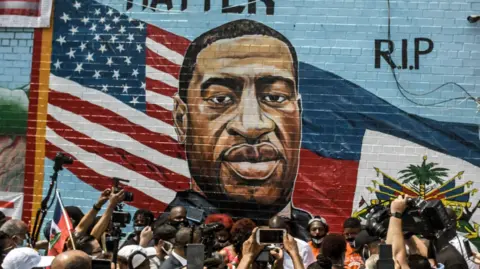 Getty Images
Getty ImagesThe beginning of the end for Colston's close relationship with Bristol began thousands of miles away in Minneapolis, Minnesota, on 25 May, 2020.
Police were called to a grocery store to reports of a 46-year-old man allegedly paying for a pack of cigarettes with a counterfeit $20 bill. That man was George Floyd.
Former police officer Derek Chauvin knelt on Mr Floyd's neck for more than nine minutes during his arrest. Mr Floyd's pleas of "I can't breathe" as he died sent shock waves around the world - including towards Bristol.
Black Lives Matter protests sprung up across the world, calling for an end to racism and police brutality.
Chauvin was convicted of Mr Floyd's murder along with three other officers - Tou Thao, Thomas Lane and J Alexander Kueng - who were convicted of aiding and abetting second-degree manslaughter.
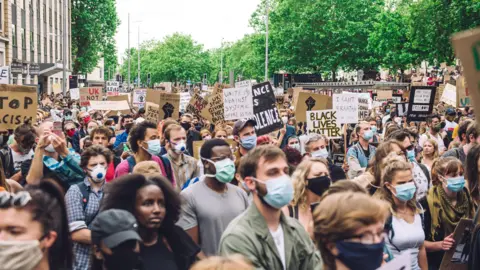 Getty Images
Getty ImagesThe Black Lives Matter protest in Bristol attracted an estimated 15,000 people who gathered on College Green before heading down to Colston Avenue, where the bronze statue was erected in honour of the slave trader in 1895.
On the day of the protest, the figure was covered up with a canvas material. It had already been targeted by egg-throwers, but the canvas was later torn off by protesters saying they wanted to look Colston in the eyes.
Shortly after the cloth was removed, three protesters climbed up to the statue and attached ropes to its head. To roars of celebration from the crowd, they pulled on the ropes and 30 seconds later the statue was on the ground.
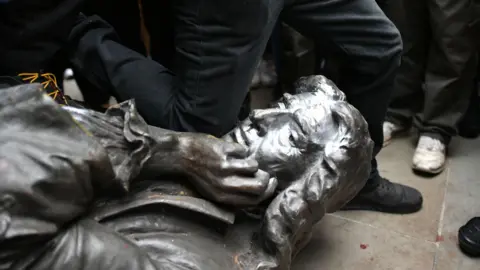 PA Media
PA MediaMany ran towards the fallen figure, jumping on it and kicking it. One protester placed his knee on the statue's neck, mirroring the actions of Chauvin during Mr Floyd's arrest. Other protesters climbed the empty plinth, chanting and holding anti-racism banners.
The statue was later dragged the short distance over to the harbour, where it was dumped into the water. For many that was symbolic, as Bristol's waterways had plenty of links with the slave trade.
Four people - dubbed the Colston Four - were charged for their involvement in the toppling, but were later acquitted of criminal damage.
 Getty Images
Getty ImagesThe toppling of the statue was dramatic. Other change has been slower, but over the last five years, Colston's name has gradually started disappearing from the city.
In fact three years before his statue was toppled, the city's largest music venue, Bristol Beacon - known formerly as Colston Hall - announced that it was considering dropping the link to Colston. Massive Attack, perhaps the most famous band from Bristol, had always refused to play the venue due to its name.
The name change proposal led to a debate, with bosses maintaining that the venue was named after the street it is located on, rather than the slave trader. There was no investment from Colston in building the venue.
Plenty of Bristolians were against the change, it should be noted, but on 23 September 2020, the Bristol Music Trust, which runs the venue, decided to go ahead with the rebrand.
Several schools in Bristol also implemented changes after the statue came down.
Colston's School in Stapleton became known as Collegiate School, Colston's Girls' School became Montpelier High School and The Dolphin Primary School changed its logo from the Colston family crest.
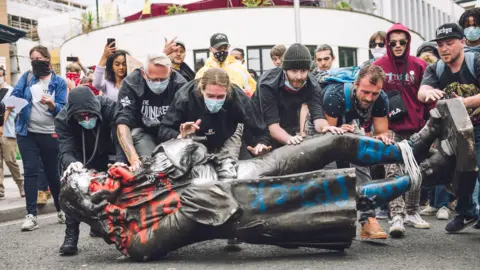 Getty Images
Getty ImagesKaren Macdonald, head of public engagement on Bristol City Council's culture team, said the toppling was "symbolic".
The statue was temporarily displayed at the M Shed museum in the city in 2021 after it was retrieved from the harbour. The council launched a public survey which more than 14,000 Bristolians responded to with "very clear wishes" of what they wanted for the statue's future.
The majority of the responses called for the statue to be displayed in its damaged state, alongside balanced historical information and context about Colston's past.
So that is where you will find the Colston statue now, lying on its back in a glass case, surrounded by the real placards left behind by the protestors.
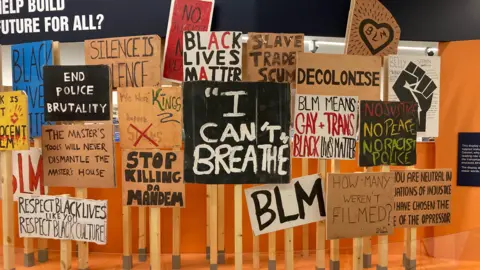
Ms Macdonald said: "There is value in listening to different viewpoints and coming to an understanding, even if you can't agree with each other.
"This isn't erasing history, this is recording history. History isn't something that can remain static and preserved - that moment was history in action.
"It wasn't about lumps of cast metal," she added.
Nothing has replaced the toppled statue, the plinth is still empty.
But it does now feature an updated plaque reflecting Colston's involvement in slavery and telling the story of that dramatic day in June.
Follow BBC Bristol on Facebook, X and Instagram. Send your story ideas to us on email or via WhatsApp on 0800 313 4630.
